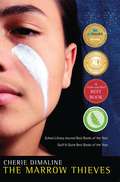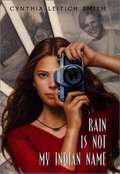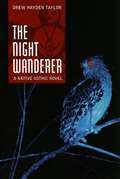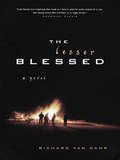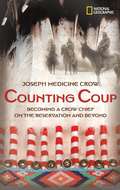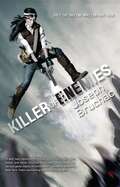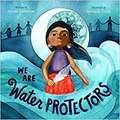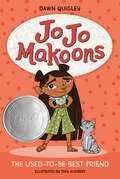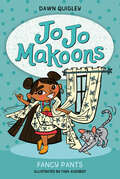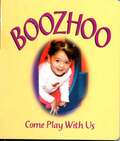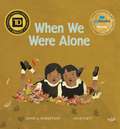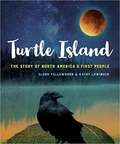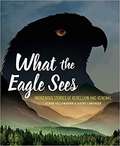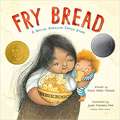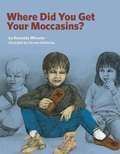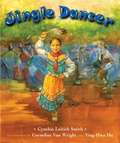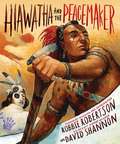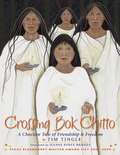Special Collections
#NativeReads for Kids and Teens
- Table View
- List View
The Marrow Thieves
by Cherie DimalineWhile working one afternoon on the Northern Divide, a young tree-marker makes a grisly discovery: in a squatter’s cabin near an old mill town, a family has been murdered.
An army vet coming off a successful turn leading a task force that took down infamous biker criminals, Detective Frank Yakabuski arrives in Ragged Lake, a nearly abandoned village, to solve the family’s murder. But no one is willing to talk. With a winter storm coming, Yakabuski sequesters the locals in a fishing lodge as he investigates the area with his two junior officers. Before long, he is fighting not only to solve the crime but also to stay alive and protect the few innocents left living in the desolate woods.
A richly atmospheric mystery with sweeping backdrops, explosive action, and memorable villains, Ragged Lake will keep you guessing ― about the violent crime, the nature of family, and secret deeds done long ago on abandoned frontiers.
Rain Is Not My Indian Name
by Cynthia Leitich SmithThe next day was my fourteenth birthday, and I'd never kissed a boy--domestic style or French. Right then, I decided to get myself a teen life. Cassidy Rain Berghoff didn't know that the very night she decided to get a life would be the night that Galen would lose his. It's been six months since her best friend died, and up until now Rain has succeeded in shutting herself off from the world. But when controversy arises around her aunt Georgia's Indian Camp in their mostly white mid western community, Rain decides to face the outside world again--at least through the lens of her camera. Hired by her town newspaper to photograph the campers, Rain soon finds that she has to decide how involved she wants to become in Indian Camp. Does she want to keep a professional distance from the inter tribal community she belongs to? And just how willing is she to connect with the campers after her great loss? In a voice that resonates with insight and humor, Cynthia Leitich Smith tells of heartbreak, recovery, and reclaiming one's place in the world.
The Night Wanderer
by Drew Hayden TaylorA sleepy native reservation. A troubled teen girl. A vampire returns home. Nothing ever happens on the Otter Lake reservation. But when 16-year-old Tiffany discovers her father is renting out "her" room, she's deeply upset. Sure, their guest is polite and keeps to himself. But he's also a little creepy.
The Lesser Blessed
by Richard Van CampA fresh, funny look at growing up Native in the North, by award-winning author Richard Van Camp.Larry is a Dogrib Indian growing up in the small northern town of Fort Simmer. His tongue, his hallucinations and his fantasies are hotter than the sun. At sixteen, he loves Iron Maiden, the North and Juliet Hope, the high school "tramp." When Johnny Beck, a Metis from Hay River, moves to town, Larry is ready for almost anything.In this powerful and often very funny first novel, Richard Van Camp gives us one of the most original teenage characters in fiction. Skinny as spaghetti, nervy and self-deprecating, Larry is an appealing mixture of bravado and vulnerability. His past holds many terrors: an abusive father, blackouts from sniffing gasoline, an accident that killed several of his cousins. But through his friendship with Johnny, he's ready now to face his memories-and his future.Marking the debut of an exciting new writer, The Lesser Blessed is an eye-opening depiction of what it is to be a young Native man in the age of AIDS, disillusionment with Catholicism and a growing world consciousness.A coming-of-age story that any fan of The Catcher in the Rye will enjoy.
Counting Coup
by Herman J. Viola and Joseph Medicine CrowThe book presents the amazing life story of Joseph Medicine Crow and illuminates the challenges faced by the Crow people as hurricanes of change raged through America.
Killer Of Enemies
by Joseph BruchacYears ago, seventeen-year-old Apache hunter Lozen and her family lived in a world of haves and have-nots. There were the Ones--people so augmented with technology and genetic enhancements that they were barely human--and there was everyone else who served them.
Then the Cloud came, and everything changed. Tech stopped working. The world plunged back into a new steam age. The Ones' pets--genetically engineered monsters--turned on them and are now loose on the world.
Lozen was not one of the lucky ones pre-C, but fate has given her a unique set of survival skills and magical abilities. She hunts monsters for the Ones who survived the apocalyptic events of the Cloud, which ensures the safety of her kidnapped family. But with every monster she takes down, Lozen's powers grow, and she connects those powers to an ancient legend of her people. It soon becomes clear to Lozen that she is not just a hired gun. As the legendary Killer of Enemies was in the ancient days of the Apache people, Lozen is meant to be a more than a hunter... Lozen is meant to be a hero.
We Are Water Protectors
by Carole LindstromInspired by the many Indigenous-led movements across North America, We Are Water Protectors issues an urgent rallying cry to safeguard the Earth’s water from harm and corruption―a bold and lyrical picture book written by Carole Lindstrom and vibrantly illustrated by Michaela Goade. Water is the first medicine. It affects and connects us all . . . When a black snake threatens to destroy the Earth And poison her people’s water, one young water protector Takes a stand to defend Earth’s most sacred resource.
Jo Jo Makoons
by Dawn QuigleyJo Jo Makoons has descriptive copy which is not yet available from the Publisher.
Jo Jo Makoons: Fancy Pants
by Dawn QuigleyFilled with lots of glitter, raised pinkies, and humorous misunderstandings, this second book in the Jo Jo Makoons series—written by Dawn Quigley and illustrated by Tara Audibert—is filled with the joy of a young Ojibwe girl discovering her very own special shine from the inside out. First grader Jo Jo Makoons knows how to do a lot of things, like how to play jump rope, how to hide her peas in her milk, and how to be helpful in her classroom. But there’s one thing Jo Jo doesn’t know how to do: be fancy. She has a lot to learn before her Aunt Annie’s wedding! Favorite purple unicorn notebook in hand, Jo Jo starts exploring her Ojibwe community to find ways to be fancy. The Heartdrum imprint centers a wide range of intertribal voices, visions, and stories while welcoming all young readers, with an emphasis on the present and future of Indian Country and on the strength of young Native heroes. In partnership with We Need Diverse Books.
Boozhoo
by Fond Du Lac Head Start Program StaffThis is a delightful picture book which invites children to play together. It also includes a pronunciation guide.
When We Were Alone
by David A. Robertson and Julie FlettWhen a young girl helps tend to her grandmother's garden, she begins to notice things that make her curious. Why does her grandmother have long braided hair and beautifully colored clothing? Why does she speak another language and spend so much time with her family? As she asks her grandmother about these things, she is told about life in a residential school a long time ago, where all of these things were taken away. When We Were Alone is a story about a difficult time in history and, ultimately, one of empowerment and strength.
Turtle Island
by Eldon Yellowhorn and Kathy LowingerUnlike most books that chronicle the history of Native peoples beginning with the arrival of Europeans in 1492, this book goes back to the Ice Age to give young readers a glimpse of what life was like pre-contact. The title, Turtle Island, refers to a Native myth that explains how North and Central America were formed on the back of a turtle. Based on archeological finds and scientific research, we now have a clearer picture of how the Indigenous people lived. Using that knowledge, the authors take the reader back as far as 14,000 years ago to imagine moments in time. A wide variety of topics are featured, from the animals that came and disappeared over time, to what people ate, how they expressed themselves through art, and how they adapted to their surroundings. The importance of story-telling among the Native peoples is always present to shed light on how they explained their world. The end of the book takes us to modern times when the story of the Native peoples is both tragic and hopeful.
What the Eagle Sees
by Eldon Yellowhorn and Kathy LowingerWhat do people do when their civilization is invaded? Indigenous people have been faced with disease, war, broken promises, and forced assimilation. Despite crushing losses and insurmountable challenges, they formed new nations from the remnants of old ones, they adopted new ideas and built on them, they fought back, and they kept their cultures alive. When the only possible “victory” was survival, they survived. In this brilliant follow up to Turtle Island, esteemed academic Eldon Yellowhorn and award-winning author Kathy Lowinger team up again, this time to tell the stories of what Indigenous people did when invaders arrived on their homelands. What the Eagle Sees shares accounts of the people, places, and events that have mattered in Indigenous history from a vastly under-represented perspective—an Indigenous viewpoint.
Fry Bread
by Kevin Noble MaillardTold in lively and powerful verse by debut author Kevin Noble Maillard, Fry Bread is an evocative depiction of a modern Native American family, vibrantly illustrated by Pura Belpre Award winner and Caldecott Honoree Juana Martinez-Neal.
Fry bread is food. It is warm and delicious, piled high on a plate.
Fry bread is time. It brings families together for meals and new memories.
Fry bread is nation. It is shared by many, from coast to coast and beyond.
Fry bread is us. It is a celebration of old and new, traditional and modern, similarity and difference.
Where Did You Get Your Moccasins?
by Bernelda Wheeler and Herman BekkeringChildren in an urban school are curious about a classmate's pair of moccasins. In answer to their questions, the boy describes in detail how his grandmother or Kookum, made his moccasins. BERNELDA WHEELER was born in Fort Qu'Appelle Valley, Saskatchewan and has lived in British Columbia, Saskatchewan, Ontario, the Northwest Territories, Manitoba, and New York. She has a rich heritage, being part Cree and part Saulteaux, with a mixture of Scottish and French. Bernelda has been a columnist, and a journalist, and was the host, writer, and broadcaster of Our Native Land on CBC national radio. She has also worked in the field of alcoholism as a rehabilitation counsellor. She is currently based in Winnipeg and works part-time at writing, broadcasting, acting, and public speaking. BerneIda has two talented children and several grandchildren. Herman Bekkering is a freelance illustrator from Winnipeg, Manitoba. * ALSO BY BERNELDA WHEELER A Friend Called Chum I Can't Have Bannock but the Beaver Has a Dam
Jingle Dancer
by Cynthia Leitich SmithJenna, a contemporary Muscogee (Creek) girl in Oklahoma, wants to honor a family tradition by jingle dancing at the next powwow. But where will she find enough jingles for her dress?
Hiawatha and the Peacemaker
by David Shannon and Robbie RobertsonBorn of Mohawk and Cayuga descent, musical icon Robbie Robertson learned the story of Hiawatha and his spiritual guide, the Peacemaker, as part of the Iroquois oral tradition. Now he shares the same gift of storytelling with a new generation.
Hiawatha was a strong and articulate Mohawk who was chosen to translate the Peacemaker’s message of unity for the five warring Iroquois nations during the 14th century. This message not only succeeded in uniting the tribes but also forever changed how the Iroquois governed themselves—a blueprint for democracy that would later inspire the authors of the U.S. Constitution.
Crossing Bok Chitto
by Tim TingleThere is a river called Bok Chitto that cuts through Mississippi. In the days before the War Between the States, in the days before the Trail of Tears, Bok Chitto was a boundary. On one side of the river lived the Choctaws. On the other side lived the plantation owners and their slaves. If a slave escaped and made his way across Bok Chitto, the slave was free.
